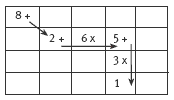This is a level 3 number activity from the Figure It Out series. It relates to Stage 6 of the Number Framework.
A PDF of the student activity is included.
Click on the image to enlarge it. Click again to close. Download PDF (555 KB)
solve problems involving operation-signs and basic facts
The cumulative calculations required in this activity will give the students plenty of opportunities to practise using the order of operations conventions.
One of the challenges facing the students is how to record their pathway of calculations. Discuss this with them. Some students may choose to list each set of calculations, such as 8 + 2 = 10, 6 x 5 = 30, and 3 x 1 = 3, and then the pathway, in this case, 10 + 30 + 3 = 43.
Others may use a template of a 5 by 4 set of squares and write in the operations and numbers of the squares that are on the path they have chosen. The path for 8 + 2 + 6 x 5 + 3 x 1 would look like this:
After the students have explored various ways of recording their pathway of calculations, make sure that you show them how to record all the steps taken in one equation only rather than in a series of equations. Help them to see the connection between this equation and the way they record their chosen path. This will provide
the opportunity for you to work with the students on the conventions of the order of operations that should be used in complex equations. The students can then practise writing complex equations for other pathways.
Use special challenges to add interest to the activity. For example, be the first to find:
• the shortest route
• a long route (for example, 8 + 7 + 4 + 1 + 9 + 2 + 5 + 6 + 2 + 3 – 6 + 9 – 1 – 3 – 0 – 4 – 1 + 2 = 43)
• the most routes
• a route to a different prime number (for example, 8 + 3 + 6 + 9 + 8 + 1 + 2 = 37)
• an equation that uses division (for example, 8 ÷ 2 x 6 + 9 + 8 + 2 = 43)
• an equation that uses all four operations (for example, 8 x 7 ÷ 2 + 9 + 8 – 2 = 43).
Answers to Activity
1. Some possibilities are:
8 x 3 + 9 + 8 + 2 = 43
(8 + 2) x 6 – 9 – 8 = 43
8 x 7 + 4 – 6 x 5 + 2 x 3 + 4 + 1 + 2 = 43
(8 + 3) x 6 – 9 – 8 – 2 x 3 x 1 = 43
(8 + 7) x 2 + 9 + 1 + 2 + 1 = 43
2. Many equations are possible. Some possibilities are:
9 x 5 + 3 – 4 – 1 = 43
(9 + 1) x 5 – 3 x 2 – 1 = 43
9 x 2 + 3 x 6 + 1 + 3 + 2 + 1 = 43

